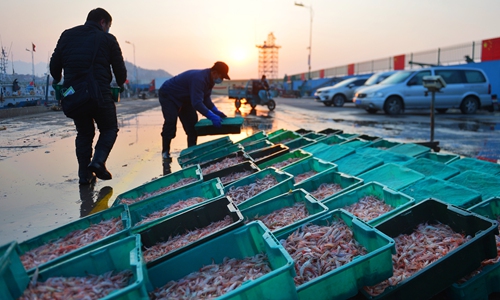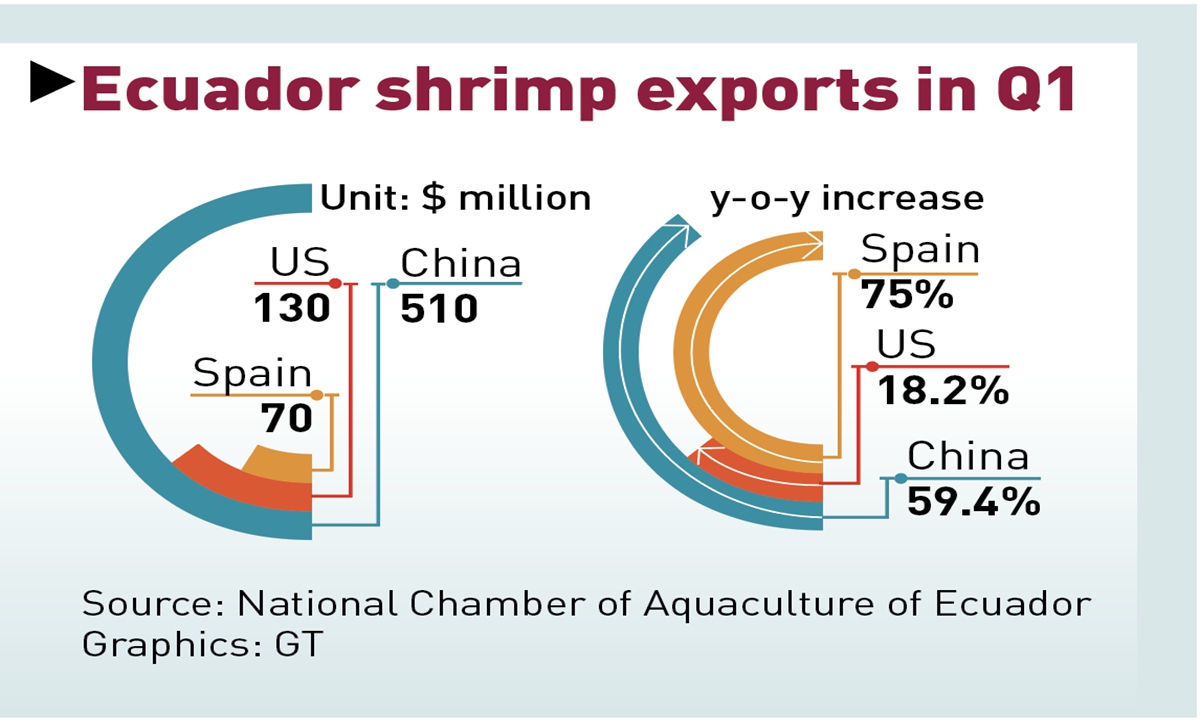Shrimp new headache for Chinese importers
By Yang Kunyi and Yin Yeping Source: Global Times Published: 2020/7/12 19:43:40
Coronavirus found with Ecuadorian products

Five fishing boats at fishing port at Qingdao, East China's Shandong Province, have brought back about 35 tons of shrimp and fish to boost market supply. Photo: cnsphoto

Graphics: GT
Chinese seafood importers are frustrated after shrimps from Ecuador tested positive for the coronavirus, and many are halting frozen seafood imports amid mounting fears of plunging market demand and policy uncertainties.
On Friday, China's General Administration of Customs (GAC) suspended imports from three Ecuadorean shrimp producers, after imported samples tested positive for COVID-19.
Although only three companies are now banned, seafood importers worry that recent flare-ups of the coronavirus, all related to imported frozen seafood, may cause customers to avoid all imported seafood just to be safe.
A manager surnamed Yang from a large seafood import company based in North China's Hebei Province told the Global Times that although its Ecuadorian suppliers are not banned by the GAC, many long-term clients, including the country's biggest food company China National Cereals, Oils and Foodstuffs Corp, rejected Ecuadorian shrimps as soon as news about the COVID-19 risks broke Friday.
"Although the GAC only banned three companies and told us to destroy products imported after March 12, our clients are now refusing to accept the shrimps, even though they tested negative when arriving at customs," Yang said.
The company has about 80 containers of Ecuadorian shrimps stranded in North China's Tianjin municipality. With 50 more containers to come, the company will have shrimps worth over 100 million yuan ($14.3 million) stocked up in the port city.
Cui He, president of the China Aquatic Products Processing and Marketing Alliance, said he believes that the suspension of the frozen white shrimps from the three Ecuadorian exporters will inflict "short-term and manageable" damage, given the Chinese market's huge demand.
China is the top export destination for Ecuadorian shrimps. In the first quarter, shrimp exports from Ecuador to China totaled $510 million, more than its exports to the US and Spain combined. In the first quarter last year, exports maintained a healthy growth rate of 33 percent, according to statistics from Ecuador's National Chamber of Aquaculture.
However, for importers of frozen seafood like Yang, it is not long-term market demand but rising policy uncertainties and confusion that threaten the industry.
"With the frozen shrimp stranded in Tianjin port, the monthly expense, including inventory and capital costs, is 1.2 million yuan per month," Yang said. "We are also paying about 240,000 yuan to our staff every month to do nothing."
Although there is no evidence suggesting seafood poses higher coronavirus risks, people in the business fear that the recent seafood-related coronavirus cases could seriously dampen customer demand.
"Salmon was the first to be called out, and now it's shrimp," Fan Xubing, president of Beijing Seabridge Marketing, a leading importer of shrimps, told the Global Times. "Back at the beginning of the COVID-19 epidemic, the outbreak at the Wuhan seafood market already had some impact on seafood sales."
Yang said that his company and many other importers have halted importing frozen seafood amid the uncertainty.
For customers, though, the situation may not mean a significant shortage in the market, thanks to China's rising domestic agricultural industry.
According to Cui, China is the world's largest producer of South American white shrimps. Almost every coastal province from Liaoning in the northeast to Hainan Province in the south has South American shrimp farms.
Imports of white shrimps from Ecuador amount to less than one-third of China's production, Cui said, while imports from India, the second largest exporter, account for less than one-quarter.
Newspaper headline: Shrimp imports a new worry
Posted in: ECONOMY